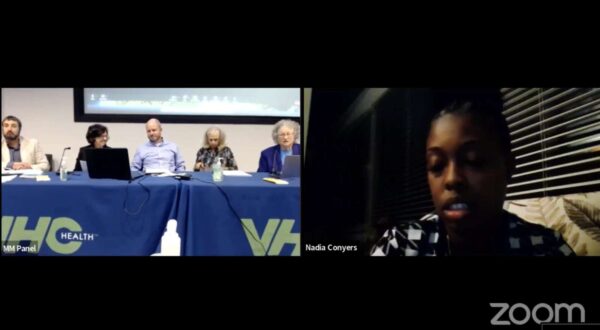
Before four panelists could jump into discussing Missing Middle housing, moderators of Arlington County Civic Federation‘s forum last night (Tuesday) did something unusual.
They laid out ground rules for civil discourse, as other community discussions of the county’s proposed zoning changes have gotten loud, and even rowdy.
Arlington County is gearing up to make a decision on whether to allow low-rise, multifamily dwellings to be built on lots currently zoned exclusively for single-family homes. Leading up to the decision, the county and local organizations have been holding many discussions about the potential impacts of these changes.
Panelists, who spoke for themselves, couldn’t discuss their “feelings” and would instead have to provide a citation for every fact or projected outcome, co-moderator Nadia Conyers said. Speakers needed to seek common ground and respect areas of disagreement, and could not attribute motives to what other speakers were saying.
The panelists reviewed each other’s presentations to ensure facts were not misrepresented, co-moderator Jackie Snelling said.
“We spent a lot of time planning this discussion, which is a little different from how our normal discussions go,” she said.
Those in favor of Missing Middle said Arlington’s housing shortage requires the county to do something.
Michael Spotts, the founder of Neighborhood Fundamentals, who has researched housing for the last 15 years, said Arlington as it is currently zoned is running out of developable space. Meanwhile, developers are tearing down starter homes to build so-called McMansions, while certain neighborhoods north of Route 50 are essentially off-limits to renters, he said.
“I believe Arlington does need to grow and continue to add new housing,” Spotts said. “Aside from the economics, I don’t believe it’s fair to say certain neighborhoods shouldn’t have to contribute to meeting the growing need for housing.”
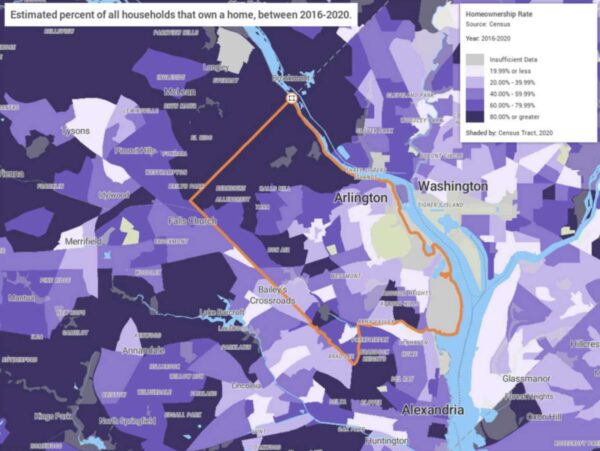
While not a panacea for all of the county’s housing concerns, he says the zoning changes would add units, increase ownership opportunities and marginally cut down on sprawl development in Loudoun, Fairfax and Prince William counties, which in turn has environmental impacts in Arlington.
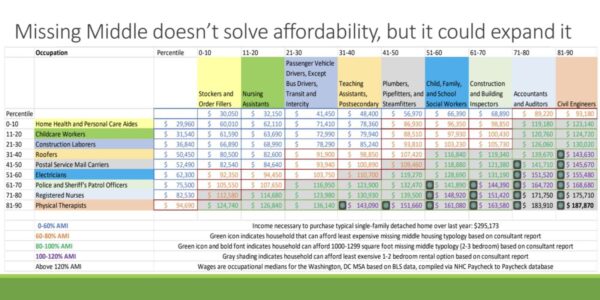
He and Eric Berkey, who chairs Arlington’s Housing Commission, said the changes would help undo the lasting effects of last century’s exclusionary and racist zoning policies. After racially restrictive covenants became illegal, Arlington County used economics to segregate Black people by banning the construction of row houses and creating zones for exclusively single-family detached houses.
“Missing Middle can provide opportunities for more families to live in not just the three or four neighborhoods where we have duplexes, but the entirety of the county in the long term,” Berkey said. “Characters make the neighborhood. It’s important for the county to get rid of these exclusionary housing policies and make sure folks can live in the entirety of our community.”
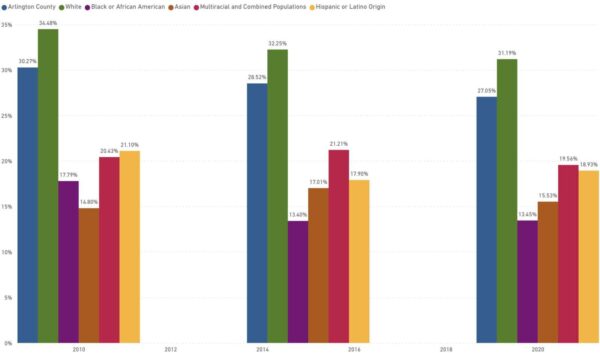
Opponents Anne Bodine, a member of Arlingtonians for Our Sustainable Future, an advocacy group concerned about rapid growth, and Julie Lee, a member of a coalition of 15 civic association presidents opposed to the framework, said more housing is needed, but Arlington does not need to pick up the slack for a region-wide shortage.
“We cannot solve all of the region’s housing issues, but we should set lofty goals, and we must implement a plan that would achieve our desired objective,” Lee said. “The Missing Middle plan does not do that.”
They argued that the zoning changes won’t make it easier for people of color and low- and middle-income earners to buy here, despite assertions to the contrary by the local chapter of the NAACP and others.
“The county says offering a diversity of housing types is a key Missing Middle goal. Why do we need diverse housing types that don’t promote racial and economic diversity?” Bodine said. “A household needs to earn 118% of the area median income to afford the cheapest Missing Middle unit of $416,000. Looking at current Arlington populations, senior, Hispanic and Black median household incomes fall short. It doesn’t mean none of these groups can afford Missing Middle units, but it shows how slim the chances are.”
She added that Missing Middle distracts from the larger problem of a lack of affordable housing options, for people who earn 50% or less of the area median income. The county has a deficit of units affordable to them, and a surplus to people earning above 80% AMI, according to the 2022 update to the Affordable Housing Master Plan Implementation Framework.
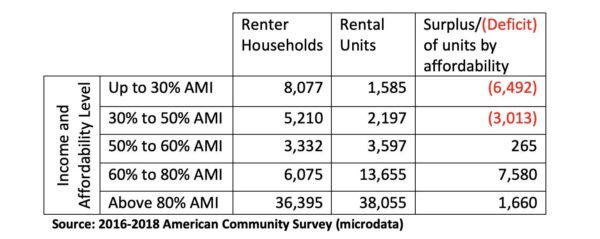
Meanwhile, Missing Middle would not necessarily ensure housing ownership opportunities, Lee said.
“There’s nothing here to prevent these units being built as rentals,” she said. “Over 80% of Arlington’s 2-9 unit buildings are currently rentals. Just recently, in Brooklyn, a private equity fund spent $500 million purchasing 2-8-unit buildings to be used as rentals there. The county needs to study this.”
Currently, 90% of Arlington’s 28,000 detached homes are owner-occupied, compared with the owner-occupation rate of 20% for buildings with 2-9 units, Bodine said, citing U.S. Census Bureau statistics.
Based on a consultant’s report from April as well as earlier drafts of this report ASF obtained through a Freedom of Information request, the group projects Arlington would see a net loss of 3-bedroom units, and 90% of all new units, from duplexes and up, would have one to two bedrooms. The consultant’s report projects 19-21 lots would be redeveloped for Missing Middle annually, and of those, Bodine says, two-thirds would likely be replaced with six-plexes or eight-plexes.
“This program is going to benefit people earning almost 120% of the area median income, while people at the lower end of the spectrum are being frozen out of housing,” Bodine said. “With fewer ownership and family-sized units, residents may end up moving out to realize the home ownership opportunities they had hoped for in Arlington.”
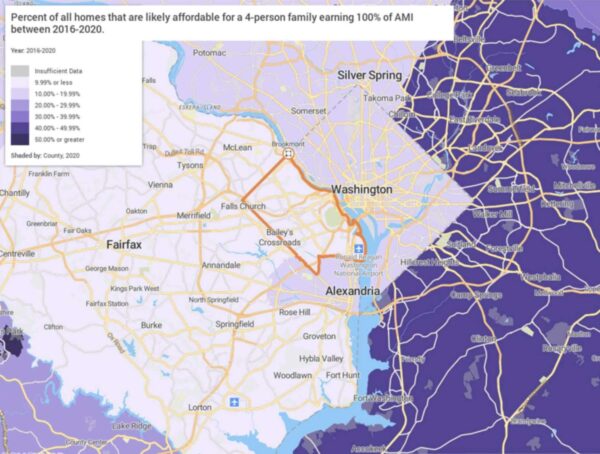
Spotts disagreed.
“If we don’t add housing across the spectrum, it’s eventually going to trickle down to lowest-income residents,” he said. “The Columbia Gardens apartments, which were market-rate rentals that were affordable, generally speaking, to lower-income renters, are being torn down to produce townhomes. Because we can’t build Missing Middle typology in single-family neighborhoods, that demand flows somewhere. It flows historically to where lower-income renters live.”
Converting renters to homeowners could lessen Arlington’s indirect contribution to deforestation and paving in Fairfax, Loudoun and Prince William counties, he asserted.
“It’s important that we don’t reduce options for living in places that enable lower carbon footprints. As of 2017, Arlington’s per household annual emissions were about three tons lower than region as a whole,” Spotts said. “We should do more to address trees and runoff issues here but Arlington isn’t protected by a biodome.”
Bodine says under Missing Middle, Arlington could lose 584 acres of tree canopy and would reverse the gains Arlington made by concentrating development along Metro corridors, as the targets of Missing Middle changes are not as transit accessible.
Lee added that many older, smaller neighborhoods can’t support more street parking, especially if bike lanes and sidewalks are also added. She said 70% of residential neighborhood streets already do not meet the 20-foot minimum width for emergency vehicles.
To prove that point, she included a picture of a waste removal truck squeezing past a school bus in the Aurora Hills neighborhood, near Pentagon City.

“The county has no plan to prevent geographic dispersion or prevent concentration of development in certain neighborhoods,” she said. “There must be caps neighborhood by neighborhood to preclude this type of over development.”
Ultimately, Berkey said, the county has to somehow reconcile the divergent views of renters and owners, the latter of which tend to be more active in civic conversations. A county survey found 77% of renters said the county should not exclude any housing types from the its Missing Middle study, while 75% of homeowners said staff should exclude some housing types.
“There does seem to be a discrepancy between what a lot of our folks who are homeowners might want and what a lot of folks who are renters might want,” he said. “What I would ask of CivFed and our civic groups is to think about, ‘Are we reaching everybody in our community? Are we trying to be representative?’ And, ‘If we can’t be representative, how do we account for the people who can’t make it to the meeting or can’t make it to the discussion?'”
In some concluding remarks, Conyers, a Black woman, remarked on last night’s lack of representation. All the panelists were white.
“Moving forward, I hope the panel is diverse not just on opinion, but on race,” she said. “We have a housing issue, period, and we need to make sure it’s not just the people who speak the loudest who get heard.”
The next county conversation, on the topic of planning for growth, is tonight (Wednesday) at 7 p.m. Participants can call or text their questions to (571) 348-3053. Meanwhile, the Northern Virginia Association of Realtors and George Mason University are co-hosting a panel tomorrow (Thursday) from 9-11 a.m. Attendees are asked to register for the free event.

